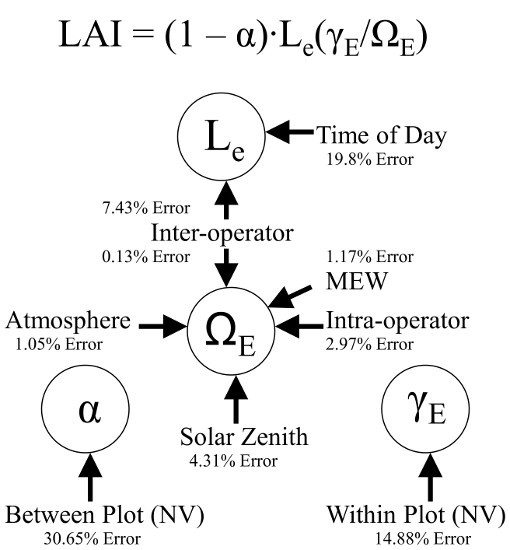Uncertainty Analysis in the Creation of a Fine-Resolution Leaf Area Index (LAI) Reference Map for Validation of Moderate Resolution LAI Products
Abstract
:1. Introduction
1.1. Elements of Variation
1.1.1. Natural Variation (P. taeda)
1.1.2. Measurement Uncertainty: In Situ Optical Parameters
1.1.3. Measurement Uncertainty: Land Cover Classification Variability
1.2. Study Objective
Study Area
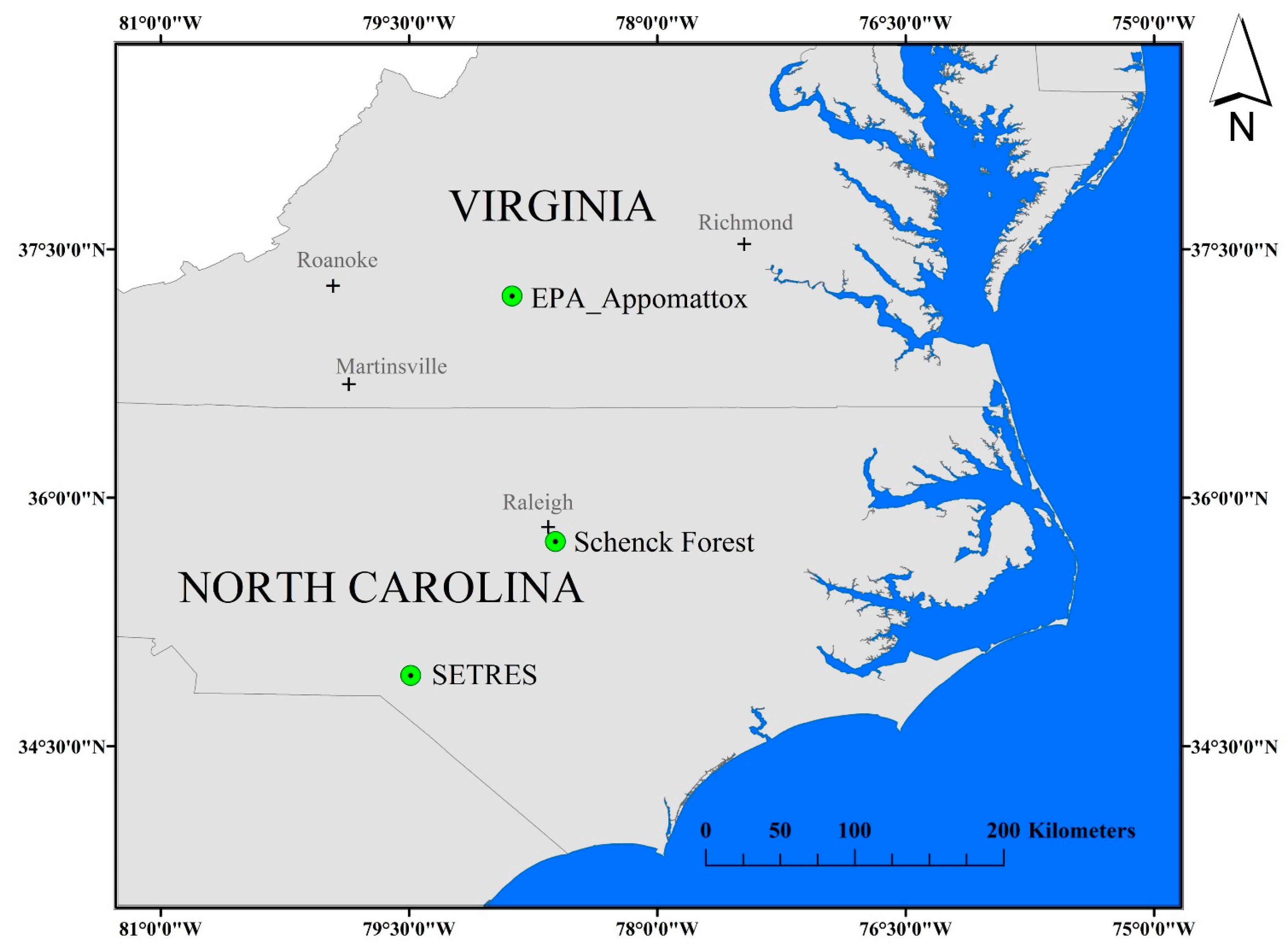
2. Methods
2.1. Modified Beer-Lambert Input Uncertainty (ΩE—TRAC, Le—DHP, λE and α—Field and Laboratory)
2.1.1. Sampling Design: Optical Instrument Descriptions and Plot Design
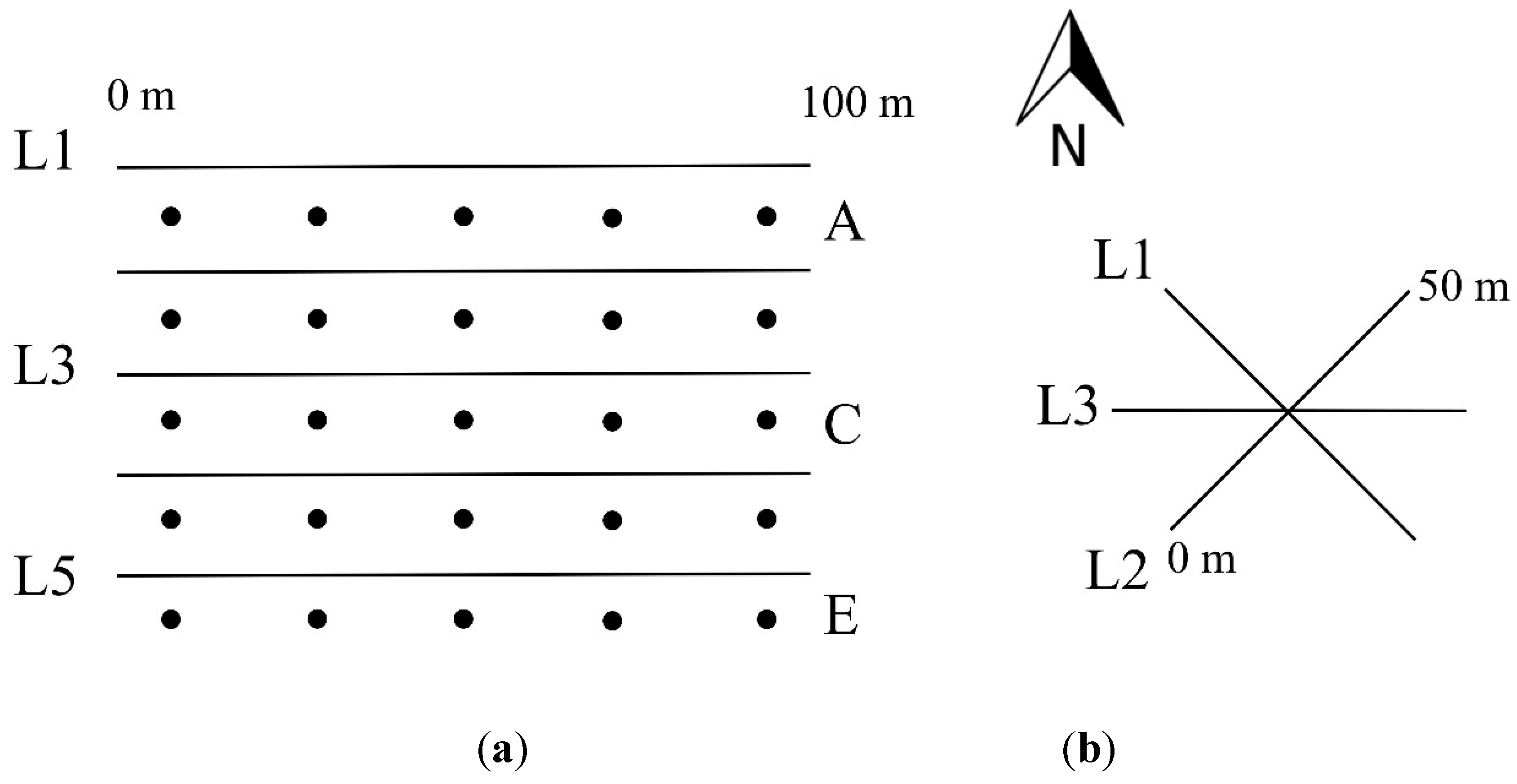
2.1.2. Modified Beer-Lambert Uncertainty
2.2. Land Cover Classification Uncertainty
2.3. Upscaling Process

2.4. Uncertainty Analysis
3. Results
3.1. Modified Beer-Lambert Input Uncertainty (ΩE—TRAC, Le—DHP, λE and α—Field and Lab)
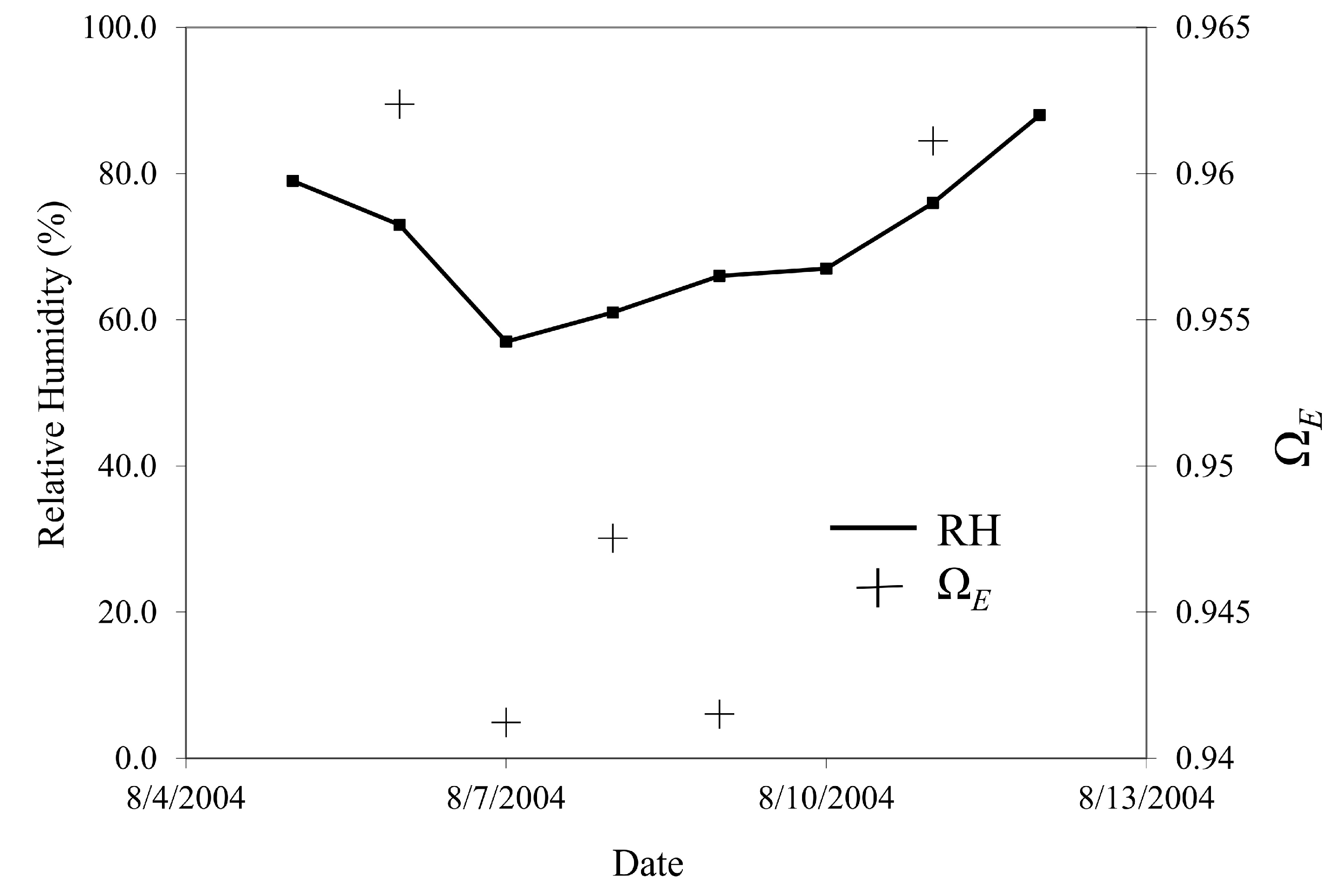
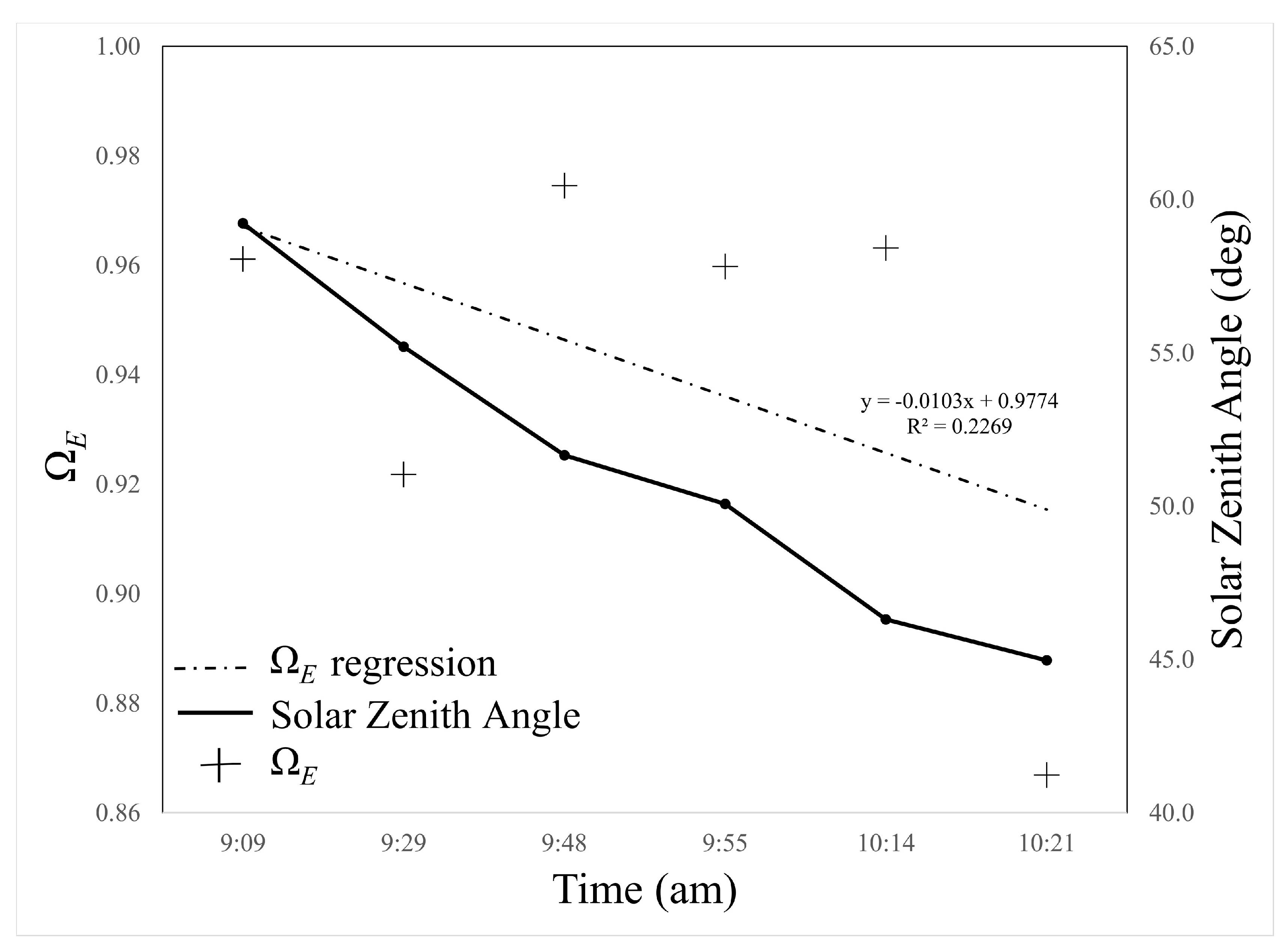
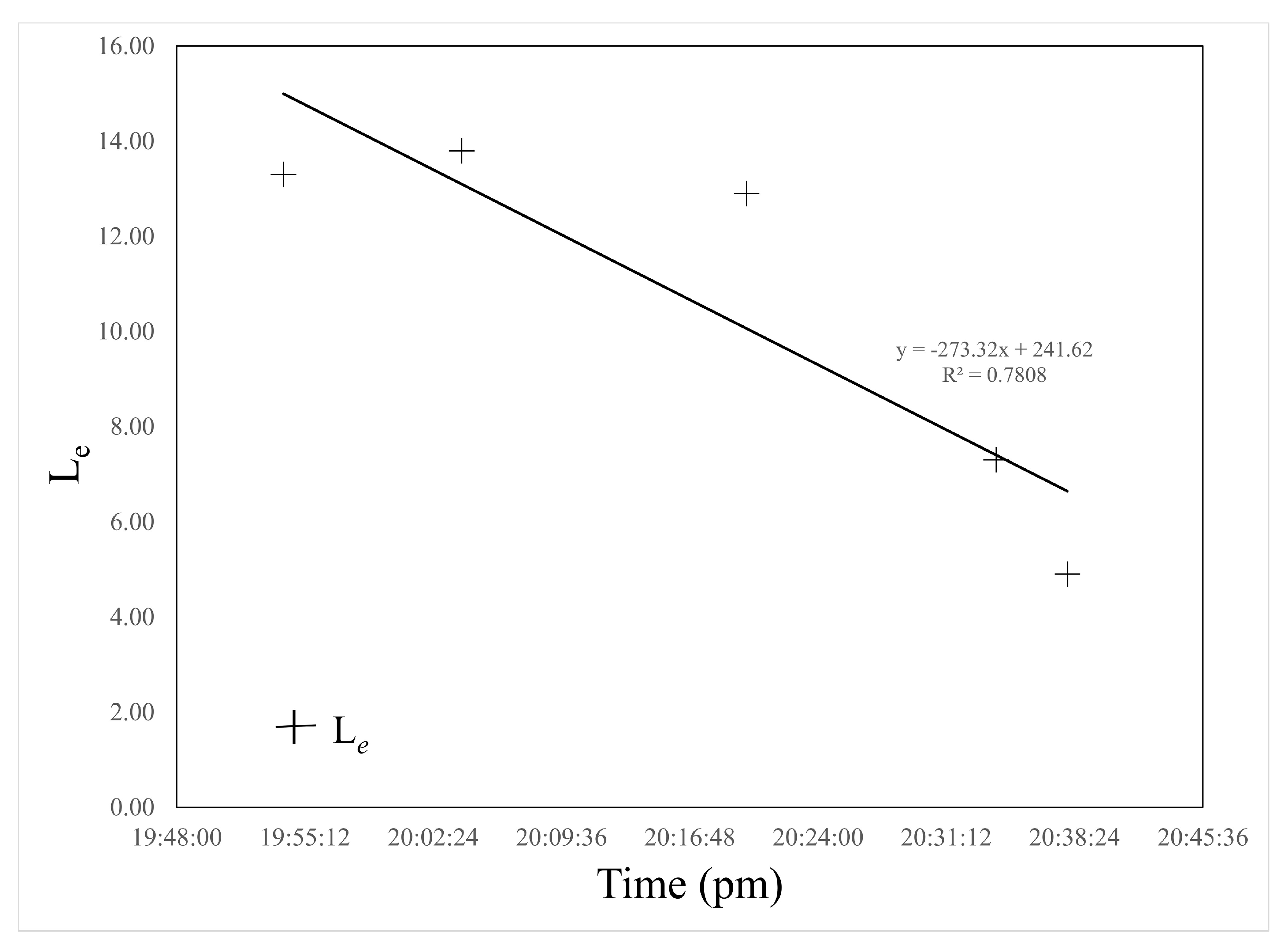
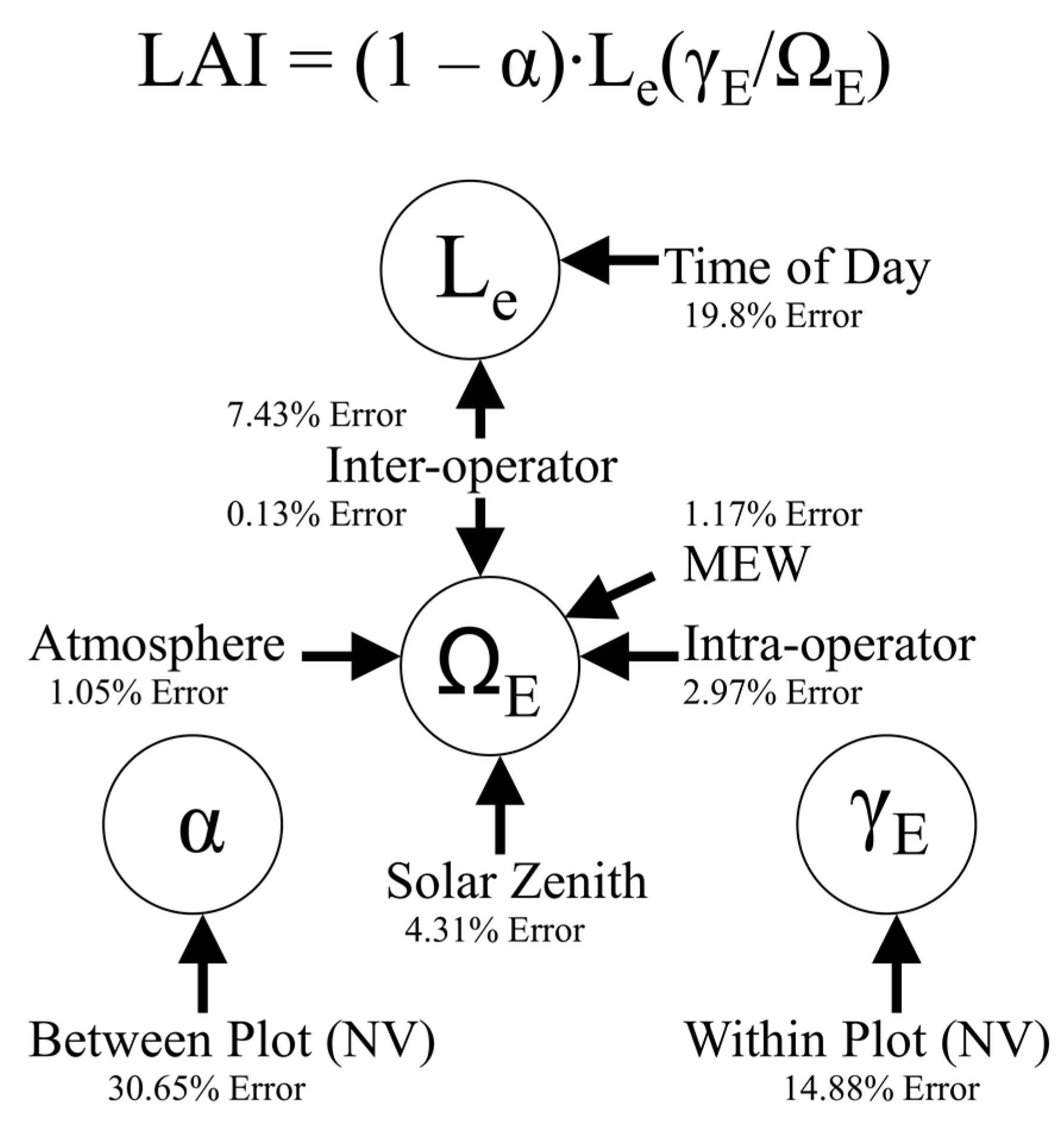
3.2. Land Cover Classification Uncertainty
| LC | Number | Reference (%) | Mean (%) | Min (%) | Max (%) | σ |
|---|---|---|---|---|---|---|
| HDWD | 1 | 30.8 | 32.2 | 27.5 | 37.6 | 3.6 |
| PINE | 2 | 32.0 | 31.8 | 26.4 | 36.8 | 4.1 |
| Unthinned | 2a | 25.6 | 27.5 | 22.8 | 31.4 | 3.4 |
| Thinned | 2b | 6.3 | 4.3 | 3.5 | 5.4 | 0.8 |
| OV | 3 | 37.2 | 36.0 | 33.5 | 39.1 | 2.2 |
| AG | 3a | 6.0 | 5.0 | 4.7 | 5.6 | 0.3 |
| Harvested | 3b | 31.2 | 31.0 | 28.6 | 33.5 | 2.0 |
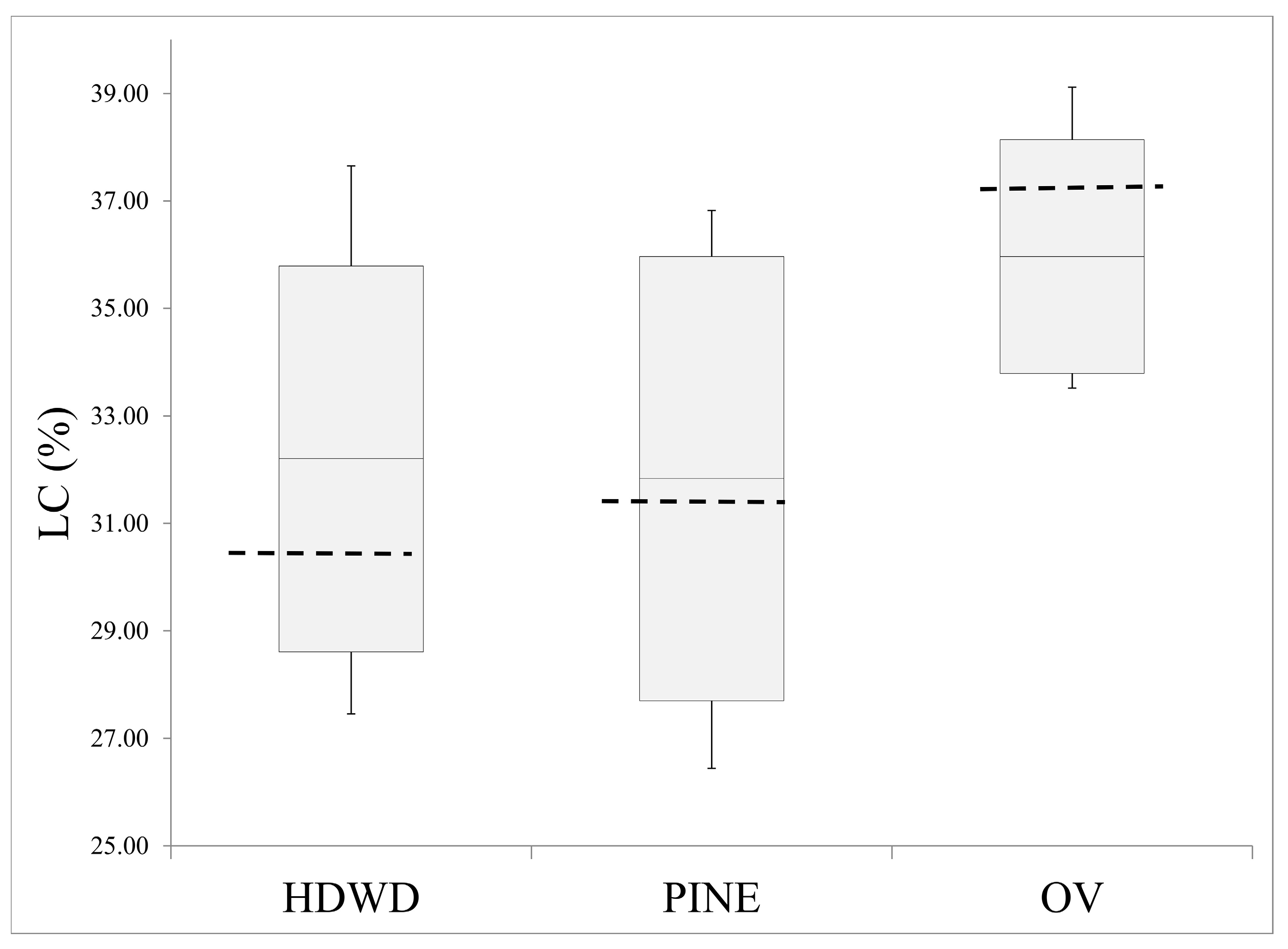
3.3. Upscaling Process
| LC | LAI per LC class | Area(%) | LAI per 1 km2 | ||
|---|---|---|---|---|---|
| σ | σ | ||||
| HDWD | 2.87 | 0.818 | 29.7 | 0.85 | 0.243 |
| PINE Unthinned | 2.15 | 0.383 | 27.9 | 0.60 | 0.107 |
| PINE Thinned | 1.93 | 0.591 | 7.3 | 0.14 | 0.043 |
| OV | 0.38 | 0.274 | 28.4 | 0.11 | 0.078 |
| AG | 1.94 | 0.402 | 6.7 | 0.13 | 0.027 |
| Total | 1.83 | 0.498 | |||
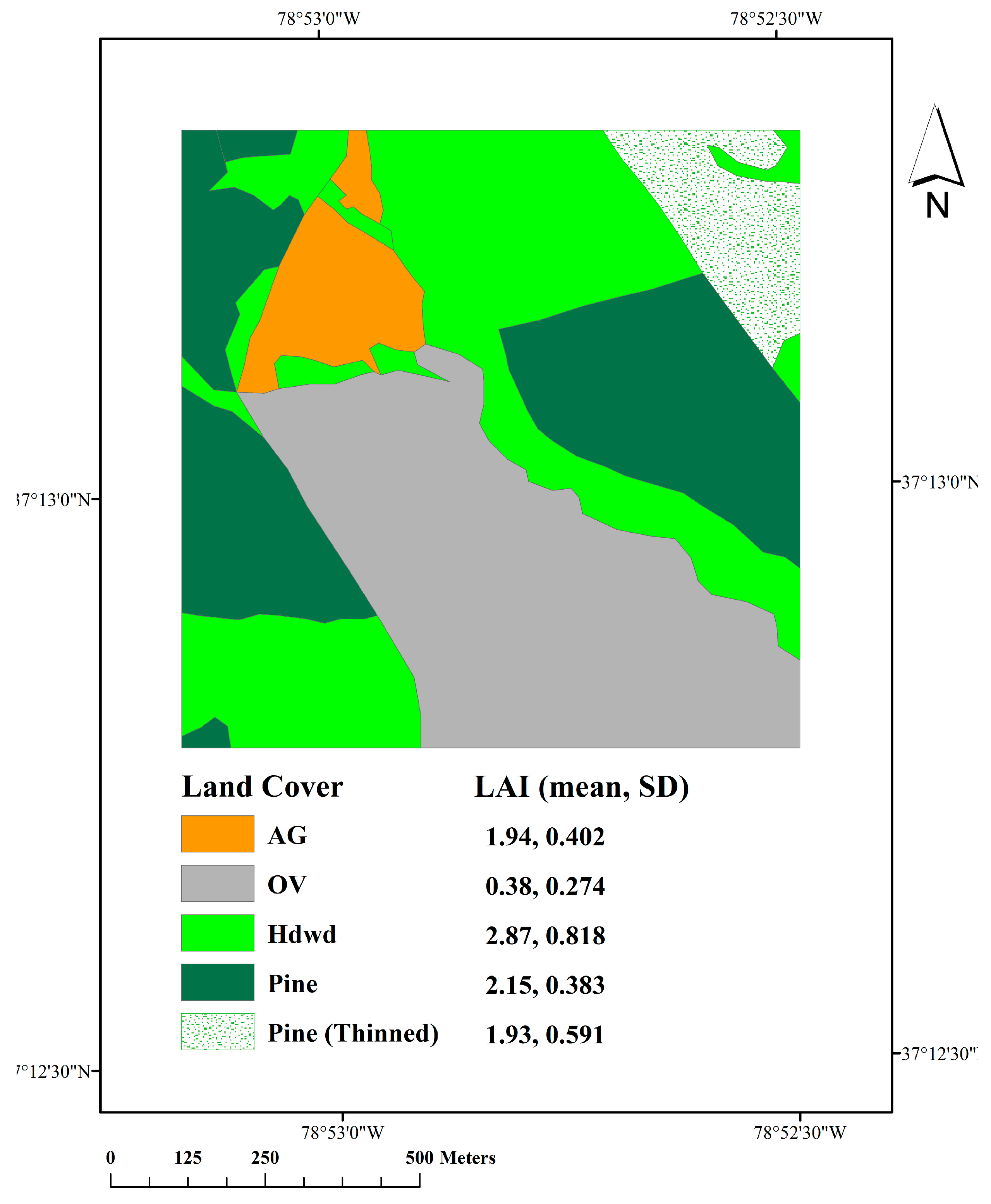
3.4. Uncertainty Analysis
- LE: 19.86% + 7.4% = 27.2%
- ΩE: 2.97% + 1.17% + 1.05% + 4.13% = 9.3%
- α: 30.6%
- λE: 14.88%
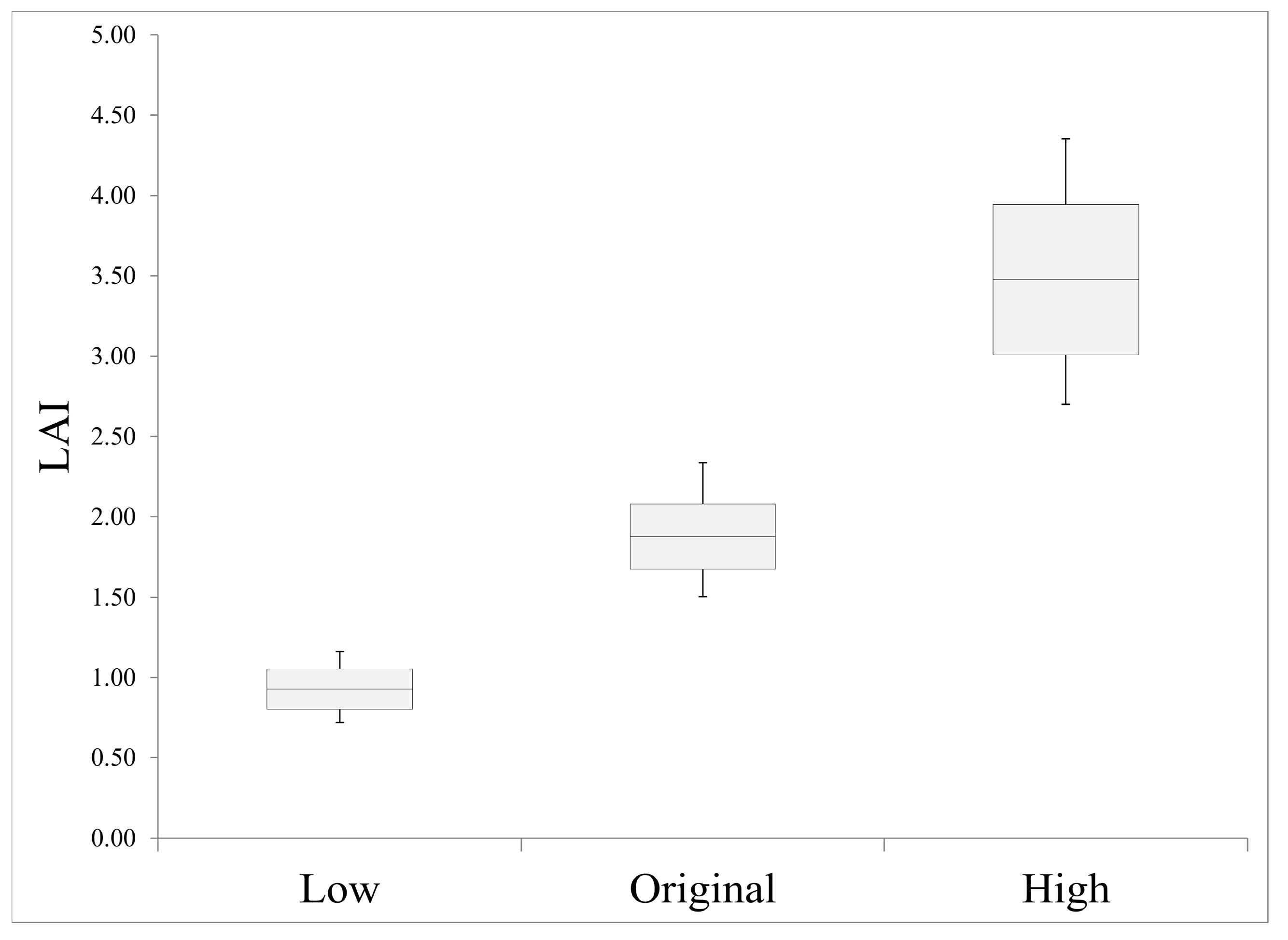
| Stat | Unthinned Pine Only | Unthinned Pine and LC | |||||||
|---|---|---|---|---|---|---|---|---|---|
| L7-O | L7-L | L7-H | % Dec | % Inc | L7-L | L7-H | % Dec | % Inc | |
| Min | 1.04 | 1.01 | 1.31 | - | - | 1.01 | 1.34 | - | - |
| Max | 2.97 | 2.90 | 3.75 | - | - | 2.89 | 3.86 | - | - |
| 1.83 | 1.78 | 2.34 | 2.8 | 27.9 | 1.77 | 2.42 | 3.4 | 32.2 | |
| σ | 0.50 | 0.50 | 0.59 | - | - | 0.49 | 0.59 | - | - |
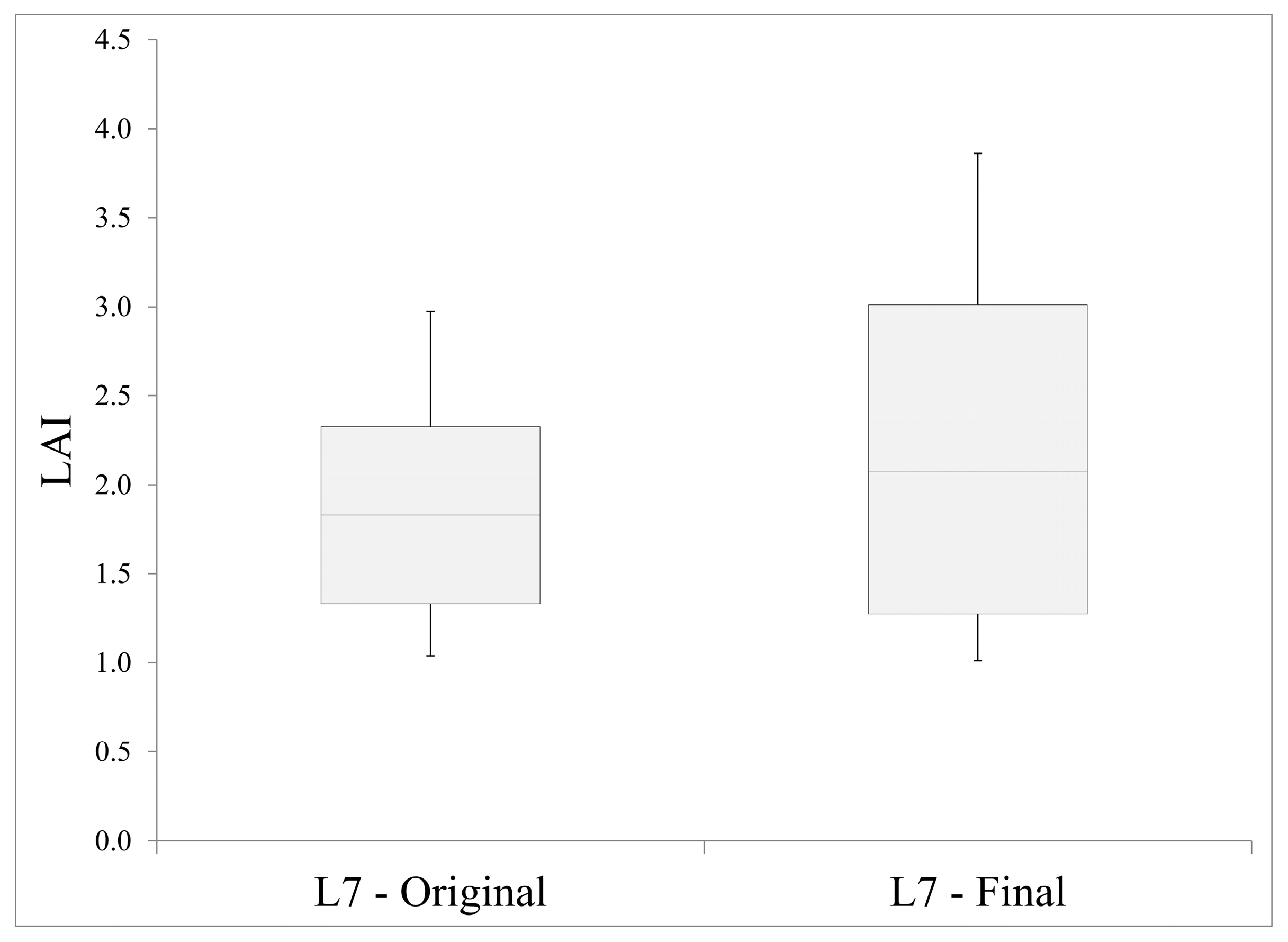
4. Discussion
4.1. Modified Beer-Lambert Input Uncertainty (ΩE—TRAC, Le—DHP, λE and α—Field and Laboratory)
4.2. Land Cover Classification Uncertainty
4.3. Upscaling and Uncertainty Analysis Processes
5. Conclusions
Acknowledgments
Author Contributions
Conflicts of Interest
References
- Chen, J.M. Optically-based methods for measuring seasonal variation of leaf area index in boreal conifer stands. Agr. Forest Meteorol. 2006, 80, 135–163. [Google Scholar] [CrossRef]
- Morisette, J.T.; Baret, F.; Privette, J.L.; Myneni, R.B.; Nickeson, J.; Garrigues, S.; Shabanov, N.; Weiss, M.; Fernandes, R.; Leblanc, S.; et al. Validation of global moderate-resolution LAI products: A framework proposed within the CEOS land product validation subgroup. IEEE Trans. Geosci. Remote Sens. 2006, 44, 1804–1817. [Google Scholar] [CrossRef]
- Foody, G.M. Estimation of sub-pixel land cover composition in the presence of untrained classes. Comput. Geosci. 2000, 26, 469–478. [Google Scholar] [CrossRef]
- Huang, D.; Yang, W.; Tan, B.; Rautiainen, M.; Zhang, P.; Hu, J.; Shabanov, N.; Linder, S.; Knyazikhin, Y.; Myneni, R.B. The importance of measurement error for deriving accurate reference leaf area index maps and validation of the MODIS LAI product. IEEE Trans. Geosci. Remote Sens. 2006, 44, 1866–1871. [Google Scholar] [CrossRef]
- Abbaspour, R.A.; Delavar, M.R.; Batouli, R. The issue of uncertainty propagation in spatial decision making. In Proceedings of the 9th Scandinavian Research Conference on Geographical Information Science, Espoo, Finland, 4–6 June 2003; pp. 57–65.
- Geographic Information Technologies in Society, NCGIA Core Curriculum GIScience. Available online: http://www.ncgia.ucsb.edu/giscc/units/u098/u098.html (accessed on 27 August 2014).
- Hunter, G.J.; Goodchild, M.F. Modelling the uncertainty of slope and aspect estimates derived from spatial databases. Geogr. Anal. 1997, 29, 35–49. [Google Scholar] [CrossRef]
- Sampson, D.A.; Albaugh, T.J.; Johnsen, K.H.; Allen, H.L.; Zarnoch, S.J. Monthly leaf area index estimates from point-in-time measurements and needle phenology for Pinus taeda. Can. J. Forest Res. 2003, 33, 2477–2490. [Google Scholar] [CrossRef]
- Aerts, J.C.J.H.; Goodchild, M.F.; Huevelink, G.B.M. Accounting for spatial uncertainty in optimization with spatial decision support systems. Trans. GIS 2003, 7, 211–230. [Google Scholar] [CrossRef]
- Maier, C.A.; Johnsen, K.H.; Butnor, J.; Kress, L.W.; Anderson, P.H. Branch growth and gas exchange in 13-year-old loblolly pine (Pinus taeda) trees in response to elevated carbon dioxide concentration and fertilization. Tree Physiol. 2002, 22, 1093–1106. [Google Scholar] [CrossRef] [PubMed]
- Dougherty, P.M.; Hennessey, T.C.; Zarnoch, S.J.; Stenberg, P.T.; Holeman, R.T.; Wittwer, R.F. Effects of stand development and weather on monthly leaf biomass dynamics of a loblolly pine (Pinus taeda L.) stand. Forest Ecol. Manag. 1995, 72, 213–227. [Google Scholar] [CrossRef]
- Herbert, M.T.; Jack, S.B. Leaf area index and site water balance of loblolly pine (Pinus taeda L.) across a precipitation gradient in East Texas. Forest Ecol. Manag. 1998, 105, 273–282. [Google Scholar] [CrossRef]
- Vose, J.M. Patterns of leaf area distribution within crowns of nitrogen- and phosphorus-fertilized loblolly pine trees. Forest Sci. 1988, 34, 564–573. [Google Scholar]
- Sword, M.A.; Chambers, J.L.; Tang, Z.; Dean, T.J.; Goelz, J.C. Long-term Trends in Loblolly Pine Productivity and Stand Characteristics in Response to Stand Density and Fertilization in the Western Gulf Region. Available online: http://www.treesearch.fs.fed.us/pubs/viewpub.jsp?index=3111 (accessed on 4 September 2014).
- Teskey, R.O.; Bongarten, B.C.; Cregg, B.M.; Douherty, P.M.; Hennessey, T.C. Physiology and genetics of tree growth response to moisture and temperature stress: An examination of the characteristics of Loblolly pine (Pinus taeda L.). Tree Physiol. 1987, 3, 41–61. [Google Scholar] [CrossRef] [PubMed]
- Vose, J.; Allen, H.L. Leaf area, stemwood growth, and nutrition relationships in loblolly pine. Forest Sci. 1988, 34, 547–563. [Google Scholar]
- Colbert, S.R.; Jokela, E.J.; Neary, D.G. Effects of annual fertilization and sustained weed control on dry matter partitioning, leaf area and growth efficiency of juvenile loblolly and slash pine. Forest Sci. 1990, 36, 995–1014. [Google Scholar]
- Hennessey, T.C.; Dougherty, P.M.; Cregg, B.M.; Wittwer, R.F. Annual variation in needlefall of a loblolly pine stand in relation to climate and stand density. For. Ecol. Manag. 1992, 51, 329–338. [Google Scholar] [CrossRef]
- Stow, T.K.; Allen, H.L.; Kress, L.W. Ozone impacts on seasonal foliage dynamics of young loblolly pine. Forest. Sci. 1992, 38, 102–119. [Google Scholar]
- Albaugh, T.J.; Allen, H.L.; Dougherty, P.M.; Kress, L.W.; King, J.S. Leaf area and above- and belowground growth responses of loblolly pine to nutrient and water additions. Forest Sci. 1998, 44, 317–328. [Google Scholar]
- Yu, S.; Chambers, J.L.; Zhenmin, T.; Barnett, J.P. Crown characteristics of juvenile loblolly pine 6 years after application of thinning and fertilization. Forest Ecol. Manag. 2003, 180, 345–352. [Google Scholar] [CrossRef]
- Beer, A. Einleitung in Die Hohere Optik; Vieweg und Sohn: Braunschweig, Germany, 1853. [Google Scholar]
- Jonckheere, I.; Muys, B.; Coppin, P. Allometry and evaluation of in situ optical LAI determination in Scots pine: A case study in Belgium. Tree Physiol. 2005, 25, 723–732. [Google Scholar] [CrossRef]
- Stenberg, P.; DeLucia, E.H.; Schoettle, A.W.; Smolander, H. Photosynthetic light capture and processing from cell to canopy. In Resource Physiology of Conifers; Smith, W.K., Hinckley, T.M., Eds.; Academic Press: New York, NY, USA, 1995; pp. 3–38. [Google Scholar]
- Chen, J.M.; Rich, P.M.; Gower, S.T.; Norman, J.M.; Plummer, S. Leaf area index of boreal forests: Theory, techniques, and measurements. J. Geophys. Res. 1997, 102, 429–443. [Google Scholar]
- Chen, J.M. Optically-based methods for measuring seasonal variation of leaf area index in boreal conifer stands. Agr. Forest Meteorol. 1996, 80, 135–163. [Google Scholar] [CrossRef]
- Deblonde, G.; Penner, M.; Royer, A. Measuring leaf area index with the LI-COR LAI-2000 in pine stands. Ecology 1994, 75, 1507–1511. [Google Scholar] [CrossRef]
- Leblanc, S.G.; Chen, J.M.; Kwong, M. Tracing Radiation and Architecture of Canopies; Natural Resources Canada: Ottawa, ON, Canada, 2002. [Google Scholar]
- Iiames, J.S.; Congalton, R.G.; Lunetta, R.S. Analyst variation associated with landcover image classification of Landsat ETM+ data for the assessment of coarse spatial resolution regional/global landcover products. GISci. Remote Sens. 2013, 50, 604–622. [Google Scholar]
- Jones, K.; Neale, A.; Wade, T.; Wickham, J.; Cross, C.; Edmonds, C.; Loveland, T.; Nash, M.; Riitters, K.; Smith, E. The consequences of landscape change on ecological resources: An assessment of the US Mid-Atlantic region, 1973–1993. Ecosyst. Health 2001, 7, 229–242. [Google Scholar] [CrossRef]
- Riitters, K.; Wickham, J.; O’Neill, R.; Jones, K.; Smith, E.; Coulston, J.; Wade, T.; Smith, J. Fragmentation of continental United States forests. Ecosystem 2002, 5, 815–822. [Google Scholar] [CrossRef]
- Smith, J.; Wickham, J.; Norton, D.; Wade, T.; Jones, K. Utilization of landscape indicators to model pathogen impaired waters. J. Am. Water Resour. Assoc. 2001, 37, 1–10. [Google Scholar] [CrossRef]
- Wickham, J.; O’Neill, R.; Riitters, K.; Smith, E.; Wade, T.; Jones, K. Geographic targeting of increases in nutrient export due to future urbanization. Ecol. Appl. 2002, 12, 93–106. [Google Scholar] [CrossRef]
- Powell, R.L.; Matzke, N.; de Souza, C., Jr; Clark, M.; Numata, I.; Hess, L.L.; Roberts, D.A. Sources of error in accuracy assessment of thematic land-cover maps in the Brazilian Amazon. Remote Sens. Environ. 2004, 90, 221–234. [Google Scholar] [CrossRef]
- Gopal, S.; Woodcock, C. Theory and methods for accuracy assessment of thematic maps using fuzzy sets. Photogramm. Eng. Remote Sens. 1994, 60, 181–188. [Google Scholar]
- Tran, L.T.; Jarnagin, S.T.; Knight, C.G.; Baskaran, L. Mapping Spatial Accuracy and Estimating Landscape Indicators From Thematic Land Cover Maps Using Fuzzy Set Theory. Available online: http://www.crcnetbase.com/doi/abs/10.1201/9780203497586.ch13 (accessed on 4 September 2014).
- Foody, G.M.; McCulloch, M.B.; Yates, W.B. Classification of remotely sensed data by an artificial neural network: Issues related to training data characteristics. Photogramm. Eng. Remote Sens. 1995, 61, 391–401. [Google Scholar]
- Lunetta, R.S.; Congalton, R.G.; Fenstermaker, L.K.; Jensen, J.R.; McGuire, K.C.; Tinney, L.R. Remote sensing and geographical information system data integration: Error sources and research issues. Photogramm. Eng. Remote Sens. 1991, 57, 677–687. [Google Scholar]
- Stehman, S.V. Statistical rigor and practical utility in thematic map accuracy assessment. Photogramm. Eng. Remote Sens. 2001, 67, 727–734. [Google Scholar]
- Congalton, R.G.; Green, K. Assessing the Accuracy of Remotely Sensed Data: Principles and Practices, 2nd ed.; CRC Press: Boca Raton, FL, USA, 2009. [Google Scholar]
- Iiames, J.S.; Congalton, R.G.; Pilant, A.N.; Lewis, T.E. Validation of an integrated estimation of Loblolly pine (Pinus taeda L.) leaf area index (LAI) utilizing two indirect optical methods in the southeastern United States. South. J. Appl. Forest 2008, 32, 101–110. [Google Scholar]
- Ringold, P.L.; Sickle, J.V.; Rasar, K.; Schacher, J. Use of hemispherical imagery for estimating stream solar exposure. J. Am. Water Resour. Assoc. 2003, 39, 1373–1384. [Google Scholar] [CrossRef]
- Chen, J.M.; Black, T.A. Foliage area and architecture of plant canopies from sunfleck size distributions. Agric. Forest Meteorol. 1992, 60, 249–266. [Google Scholar] [CrossRef]
- Chen, J.M.; Black, T.A. Defining leaf area index for non-flat leaves. Plant Cell Environ. 1992, 15, 42l–429. [Google Scholar] [CrossRef]
- Fassnacht, K.S.; Gower, S.T.; Norman, J.M.; McMurtrie, R.E. A comparison of optical and direct methods for estimating foliage surface area index in forests. Agric. Forest Meteorol. 1994, 71, 183–207. [Google Scholar] [CrossRef]
- Tou, J.T.; Gonzalez, R.C. Pattern Recognition Principles; Addison-Wesley Pub. Co.: Reading, MA, USA, 1974. [Google Scholar]
- Baret, F.; Guyot, G. Potentials and limits of vegetation indices for LAI and APAR assessment (absorbed photosynthetically active radiation). Remote Sens. Environ. 1991, 35, 161–173. [Google Scholar] [CrossRef]
- Williams, D.L. A comparison of spectral reflectance properties at the needle, branch, and canopy level for selected conifer species. Remote Sens. Environ. 1991, 35, 79–93. [Google Scholar] [CrossRef]
- Bouman, B.A. Accuracy of estimating the leaf area index from vegetative indices derived from crop reflectance characteristics, a simulation study. Int. J. Remote Sens. 1992, 13, 3069–3084. [Google Scholar] [CrossRef]
- Yoder, B.J.; Waring, R.H. The normalized difference vegetation index of small Douglas-fir canopies with varying chlorophyll concentrations. Remote Sens. Environ. 1994, 49, 81–91. [Google Scholar] [CrossRef]
- Huemmrich, K.F.; Goward, S.N. Vegetation canopy PAR absorbance and NDVI: An assessment for ten tree species with the SAIL model. Remote Sens. Environ. 1997, 61, 254–269. [Google Scholar] [CrossRef]
- Cohen, W.B.; Spies, T.A.; Bradshaw, G.A. Semivariograms of digital imagery for analysis of conifer canopy structure. Remote Sens. Environ. 1990, 34, 167–178. [Google Scholar] [CrossRef]
- Cohen, W.B.; Spies, T.A. Estimating structural attributes of Douglas-fir/western hemlock forest stands from Landsat and SPOT imagery. Remote Sens. Environ. 1992, 4, 1–17. [Google Scholar] [CrossRef]
- Leblon, B.; Gallant, L.; Grandberg, H. Effects of shadowing types on ground-measured visible and nearinfrared shadow reflectances. Remote Sens. Environ. 1996, 58, 322–328. [Google Scholar] [CrossRef]
- Gitelson, A.A. Wide dynamic range vegetation index for remote quantification of biophysical characteristics of vegetation. J. Plant Physiol. 2004, 161, 165–173. [Google Scholar] [CrossRef] [PubMed]
- Flores, F.J.; Allen, H.L.; Cheshire, H.M.; Davis, J.G.; Fuentes, M.; Kelting, D.L. Using multispectral satellite imagery to estimate leaf area and response to silvicultural treatments in loblolly pine stands. Can. J. Forest Res. 2006, 36, 1587–1596. [Google Scholar] [CrossRef]
- USGS Earth Explorer. Available online: http://earthexplorer.usgs.gov/ (accessed on 27 August 2014).
- Boryan, C.; Yang, Z.; Mueller, R.; Craig, M. Monitoring US agriculture: The US department of agriculture, national agricultural statistics service, cropland data layer program. Geocarto. Int. 2011, 26, 341–358. [Google Scholar] [CrossRef]
- Mitchell, R.B.; Moser, L.E.; Moore, K.J.; Redfearn, D.D. Tiller demographics and leaf area index of four perennial pasture grasses. Agron. J. 1998, 90, 47–53. [Google Scholar]
- Chen, J.M.; Cihlar, J. Quantifying the effect of canopy architecture on optical measurements of leaf area index using two gap size analysis methods. IEEE Trans. Geosci. Remote Sens. 1995, 33, 777–787. [Google Scholar] [CrossRef]
- Chen, J.M.; Cihlar, J. Retrieving leaf area index of boreal conifer forests using Landsat TM images. Remote Sens. Environ. 1996, 55, 153–162. [Google Scholar] [CrossRef]
- Gower, S.T.; Kucharik, C.J.; Norman, J.M. Direct and indirect estimation of leaf area index, fAPAR, and net primary production of terrestrial ecosystems. Remote Sens. Environ. 1999, 70, 29–51. [Google Scholar] [CrossRef]
- Smith, J.H.; Wickham, J.D.; Stehman, S.V.; Yang, L. Impacts of patch size and land-cover heterogeneity on thematic image classification accuracy. Photogramm. Eng. Remote Sens. 2002, 68, 65–70. [Google Scholar]
- Clawges, R.; Vierling, L.; Calhoon, M.; Toomey, M. Use of a ground-based scanning LIDAR for estimation of biophysical properties of western larch (Larix occidentalis). Int. J. Remote Sens. 2007, 28, 4331–4344. [Google Scholar] [CrossRef]
- Zhao, F.; Yang, X.; Schull, M.A.; Roman-Colon, M.O.; Yao, T.; Wang, Z.; Zhang, Q.; Jupp, D.L.B.; Lovell, J.L.; Culvenor, D.S.; et al. Measuring effective leaf area index, foliage profile, and stand height in New England forest stands using a full-waveform ground-based LiDAR. Remote Sens. Environ. 2011, 11, 2954–2964. [Google Scholar] [CrossRef]
© 2015 by the authors; licensee MDPI, Basel, Switzerland. This article is an open access article distributed under the terms and conditions of the Creative Commons Attribution license (http://creativecommons.org/licenses/by/4.0/).
Share and Cite
Iiames, J.S.; Congalton, R.G.; Lewis, T.E.; Pilant, A.N. Uncertainty Analysis in the Creation of a Fine-Resolution Leaf Area Index (LAI) Reference Map for Validation of Moderate Resolution LAI Products. Remote Sens. 2015, 7, 1397-1421. https://doi.org/10.3390/rs70201397
Iiames JS, Congalton RG, Lewis TE, Pilant AN. Uncertainty Analysis in the Creation of a Fine-Resolution Leaf Area Index (LAI) Reference Map for Validation of Moderate Resolution LAI Products. Remote Sensing. 2015; 7(2):1397-1421. https://doi.org/10.3390/rs70201397
Chicago/Turabian StyleIiames, John S., Russell G. Congalton, Timothy E. Lewis, and Andrew N. Pilant. 2015. "Uncertainty Analysis in the Creation of a Fine-Resolution Leaf Area Index (LAI) Reference Map for Validation of Moderate Resolution LAI Products" Remote Sensing 7, no. 2: 1397-1421. https://doi.org/10.3390/rs70201397






